The Gift of South Dakota
Subscriptions to South Dakota Magazine make great gifts!
Subscribe today — 1 year (6 issues) is just $29!
Retracing Roads to Our Round Barns
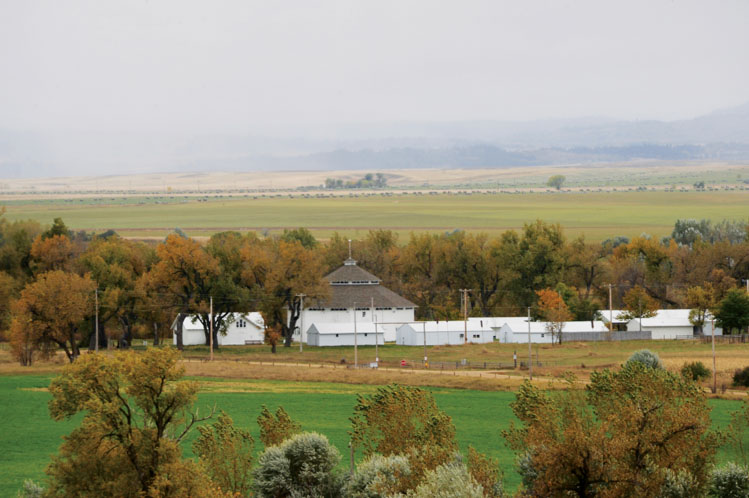 |
| A barn-like pavilion is the centerpiece of the two-county fairgrounds near Nisland. |
South Dakota Magazine staffers crisscrossed South Dakota 25 years ago in search of that rare architectural treasure — the round barn.
With help from the State Historical Society, we eventually found 29. They included livestock sales barns, the Butte-Lawrence county fairgrounds pavilion, two octagonal machine sheds and a charming, vertical-log barn near Sturgis. South Dakota never had many round barns, so forgive us for loosely interpreting the term.
We also learned that circular barn construction dates at least to the Bronze Age (hundreds of years B.C.), when boulders were used not just for castles in Britain but also for barns.
George Washington was among the first American farmers to build a barn in the round. A reconstruction of his original 16-sided barn, based on the first president’s own drawings, is a popular attraction at Mount Vernon.
The Shakers were the first Americans to experiment with round construction. A Shaker stone barn built at Hancock, Massachusetts, in 1824 is among the country’s oldest.
There’s just something about roundness. Eric Sloane, author of An Age of Barns, wrote, “Farmers made circular designs on their barns and their wives sewed circular patterns on quilts. They took delight in round hats, rugs and boxes, and they made round drawer pulls and hand rests for their severely-angled furniture.”
Anton Anfinson, a contractor from Wakonda, promoted the round barn concept in southeast South Dakota. Anfinson believed a round barn was the most efficient way to feed cattle. Many round barns featured a silo or a hole in the hay mow at the center. Livestock stood with their heads to the center at feeding or milking time, making it easier to feed the animals and clean their waste.
Most farmers who constructed round barns must have believed in Anfinson’s economic theory, but it’s likely that they were also intrigued by the thought of having something out of the ordinary.
They got what they bargained for. During our 1990s search, we found that if we got within 10 miles of a round barn and asked for help, somebody would soon have directions. Any well-kept old barn gets people’s attention, but a round barn becomes a neighborhood landmark.
“A man’s barn bespoke his worth as a man,” wrote Bob Lacy in a foreword to his book, Barn. “It expressed his earthly aspirations and symbolized the substance of his legacy to his children.”
Rural historians estimate that fewer than 3,000 round barns existed in North America, and most were built in Canada. South Dakota never had more than three or four dozen.
Twenty-five years ago, it was heartening to learn that someone cared about nearly every round barn we discovered. Over the past year, we retraced our travels and found that most of those barns still stand. Following are stories about the barns and the people who care for them in the 21st century.
Watertown
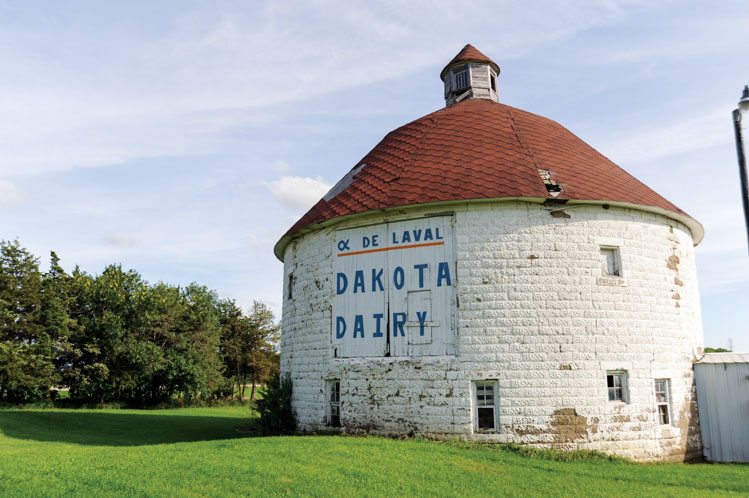 |
| The Corson Emminger barn south of Watertown along Highway 81. |
East River’s most visible round barn stands just south of Watertown along U.S. Highway 81. Corson Emminger came to South Dakota in 1905 from Wisconsin, where round barns were popular with dairy farmers, and built the 50-foot diameter barn with concrete blocks in 1910. He added an attractive cupola for good measure. The barn served as a milking parlor for decades. Today, the Emminger barn is missing a few shingles but it remains in good shape thanks to the Moeller family, its longtime owners.
1880 Town
West River’s most prominent round barn serves as a grand entry to the Hullinger family’s 1880 Town, a pioneer village located 22 miles west of Murdo along Interstate 90. Richard Hullinger remembers the day they moved the 14-sided barn from a ranch near Draper, about 45 miles away. “We came across the country on a ridge, and we had to do a little dirt work on the draws to make the crossings.” Built in 1919, before the invention of power tools, the barn’s symmetrical roof is high art to anyone who ever handled a handsaw or hammer.
Mission Hill
Norman Nelsen would be pleased to see the place he named New Hope Farm more than a century ago. Nelsen was a man who appreciated detail. He kept a journal of the materials and costs when he built an octagonal barn in 1913 as a machinery shed. “He recorded how many nails and how many boards he used, and he kept track of the costs,” says his great-grandson Chris Nelsen, who now lives on the farm, northwest of Mission Hill, with his wife Cindy and their children. “You can still see the hooks in the round barn where he hung the longest ears of corn to dry,” Nelsen says. “It was his method of doing natural seed selection.”
In 1914, Norman built a traditional rectangular barn just a stone’s throw to the west. Today, calves and sheep enjoy the big barn, and the smaller one is still used for storage. Chris and Cindy tend fastidiously to both barns — they plan to re-shingle the round barn and they recently sided and roofed the big barn, where letters atop the main door read NEW HOPE FARM.
Sioux Falls
The Shafer family has tended to a round barn on the northeast edge of Sioux Falls for many years. The barn was built of hollow block in 1919-20 by bankers Art Winters and Ray Stevens, who liked the round concept for cattle feeding. They installed a nearby scale and operated the farm like a stockyard.
However, the feeder cattle created too much moisture in the winter months, causing thick layers of ice to collect on the walls. The bankers eventually abandoned their operation and sold the barn to the Shafer family, which owns it today. For years, they operated a dairy in the barn; today it’s mostly used for storage.
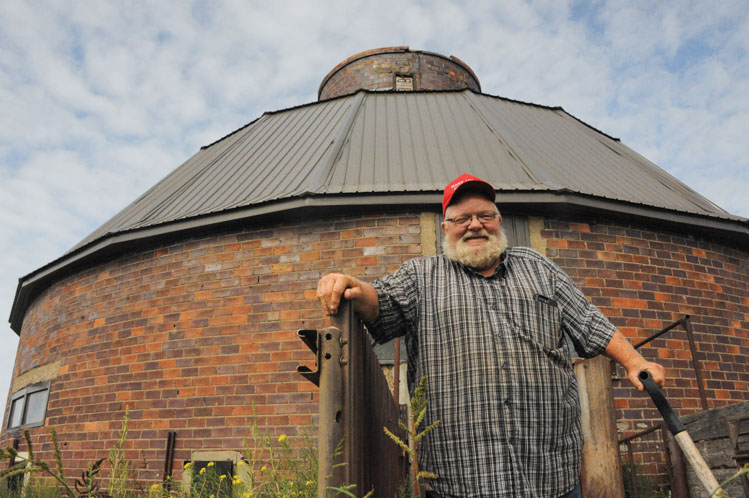 |
| Ron Hodne says Lawrence Welk and his band entertained in the round barn. |
Winfred
Lawrence Welk and his band played a few songs at a dance in the Hodne family’s big round barn southwest of Madison near the little town of Winfred. Entertaining seems to fit the Hodne family, which now operates a big hunting lodge affectionately called Hodneville (officially the Bird’s Nest) within shotgun range of the barn.
The 80-foot diameter barn was built for beef cattle in 1918. Ron Hodne’s parents bought the place in 1946 and today he lives nearby with his wife, Ev. They and three sons — Brad, Brian and Brandon — run the lodge, which can accommodate 50 overnight guests.
A few years ago, Hodne asked his sons if they thought the barn was worth preserving because it needed a $40,000 roof. “They said, ‘Do it,’” he says.
The family has used the round barn for just about everything you can raise in South Dakota — cattle, hogs and chickens. “We even tried artichokes,” Hodne jokes. It’s empty today, except for a farm cat, but he and his family may eventually find a way to incorporate it into the lodge.
Draper
The Freier barn near Draper was built from a pre-cut mail order kit, possibly from the Gordon Van Tine Company of Davenport, Iowa. It was used as a sheep barn for decades.
Renner
Blocks for a round barn on the northern outskirts of Renner were made from sand and gravel collected at a nearby pit in 1917. The Sorum family has owned the barn for generations. They used it as a dairy for many years, but in recent decades it has served as a horse stable and a cat paradise.
Gettysburg
South Dakota’s largest round barn is on the Sloat farm north of Gettysburg. Measuring 100 feet in diameter, the wood-frame structure is used for swine, beef and dairy.
Sturgis
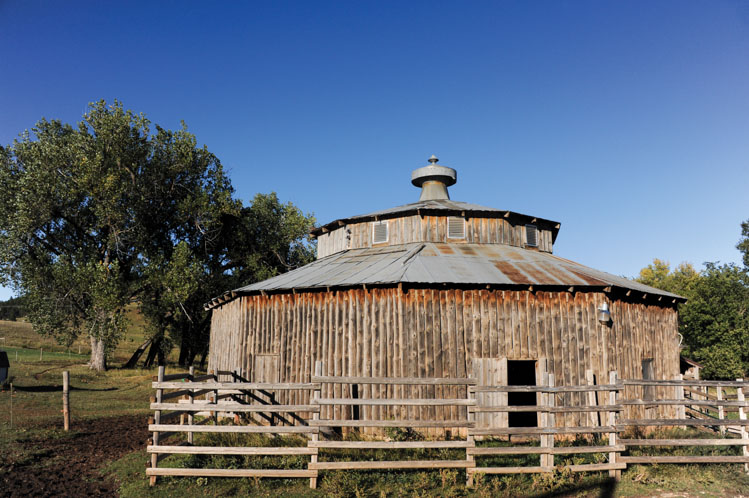 |
| A barn of vertical pine logs stands in Bulldog Gulch near Sturgis. |
South Dakota’s only round barn made of logs lies in Bulldog Gulch, just south of the Black Hills National Cemetery near Sturgis. It was built of pine logs, stood vertically on a circular concrete footing, in about 1941 by the Blairs, a prominent pioneer ranching family.
Dick and Lonna Morkert removed 2 feet of cattle manure when they bought the barn 30 years ago. Once cleaned, they found the barn was perfect for their four horses. Lonna, who then worked at a clinic in Sturgis, met the man who cut the logs. “He was an old-timer who was known for his mules,” she says. “The Blairs gave him the job of cutting the trees. He said he skidded them down from the mountain just to the west.”
Bulldog Gulch has a rich history. The 1874 Custer Expedition stopped there and watered horses at the same creek that the Morkert horses enjoy. Some think the gulch was named for Madame Bulldog, who ran a saloon there.
The Blairs arrived in 1907. They raised registered Hereford cattle and held bull sales at the log barn in the early 1940s. Dick Morkert says old-timers remembered that bidders sat on long benches.
Weddings are sometimes celebrated at the No Name City campground, which borders the Morkerts’ barn and corrals. On a few occasions, a bride with good taste in architecture will ask to have a picture taken by the very clean log barn.
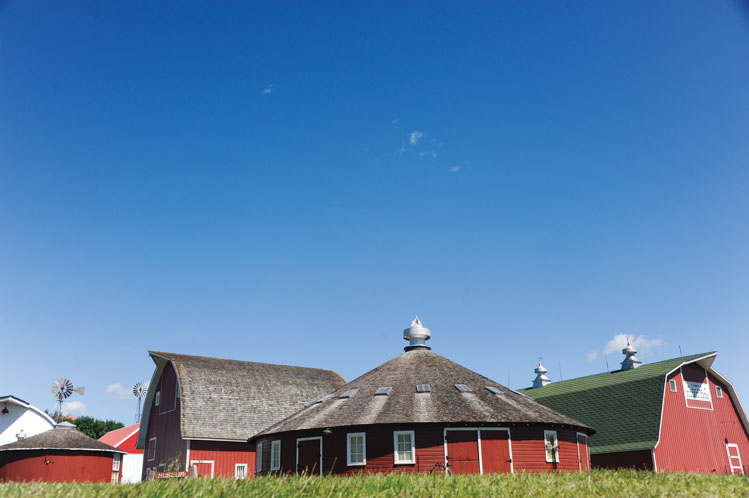 |
| A round barn is among the collection of 14 old agricultural buildings at the Little Village Farm near Trent. |
Trent
When the Big Sioux River threatened a century-old round barn near Trent in the 1990s, the landowners called Jim Lacey and said, “You need that barn!”
Lacey agreed, but moving round barns is not easy because they lack the floor beams of rectangular structures. Still, the Beckers of Marion agreed to move it with Lacey’s help, and together they brought it out of the river valley and onto what’s now known as Little Village Farm, a collection of 14 old agricultural buildings.
The village’s only other round barn is a brooder house. “It was a prefab job, probably sold by Sears or Wards,” Lacey says. “You put it together just like the old redwood water tanks, with steel bands. Tenant farmers could buy one, and then take it with them if they moved from one farm to another.” If the chickens dirtied a spot, the farmer simply pulled the brooder house to an area with fresh grass.
Jim and Joan Lacey welcome guests to their Little Village Farm, located west of Trent in Moody County. The buildings are full of farm and ranch machinery, tools and collectibles, including more than 6,000 farm caps. There is a small admission fee.
Zell
Twin 12-sided round barns sit in a horse pasture on the northeast corner of Zell, a small village west of Redfield on Highway 212. Zell was named by Benedictine sisters who built a wood monastery there in 1886 which is also standing, though showing its age.
Unityville
A big tile barn once stood just west of a little town with the fine name of Unityville in McCook County. The town was christened as Stark when it was founded in 1907, but when officials learned that there was already a Stark in North Dakota they unified around the new name. The landmark round barn was built in 1921. Unfortunately, Unityville is all but gone, the farmstead is now a cornfield and only the barn’s silo is now standing. Life is stark in Unityville.
Potter County
A 20-sided hog house built by John Nold in 1903 may be the first round barn built in South Dakota, according to a 1995 study by the South Dakota State Historical Society.
Nisland
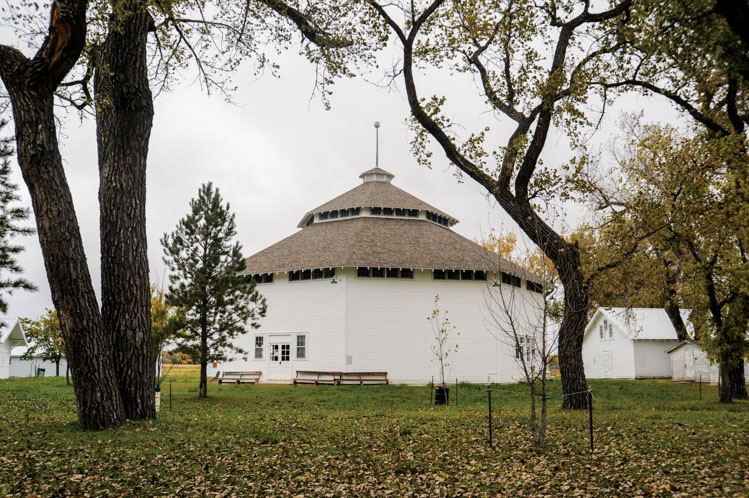 |
| The entire Butte-Lawrence County Fairgrounds is on the National Registry of Historic Places. Its jewel is the round pavilion. |
Buried in the cottonwood and oak forest of the Belle Fourche River valley lies one of America’s truly unique county fairgrounds, and its centerpiece is a century-old, octagon pavilion.
The forested 40-acre site is a mile west of Nisland in Butte County, which has shared a county fair with Lawrence County since 1980. And who wouldn’t want to share such fairgrounds?
The white-washed buildings include two long, rectangular barracks that housed German POWs during World War II. The prisoners helped farmers with the sugar beet harvest. Big-branched cottonwoods shade the buildings and grass. The entire fairgrounds are on the National Registry of Historic Places, but the pine jewel is the round pavilion. President Calvin Coolidge attended the fair and was pictured at the pavilion when he vacationed in the Black Hills in 1927.
The sturdy structure survived several calamities, including a 2012 windstorm that damaged the roof and windows. The two counties and their fair board invested nearly $300,000 in repairs and updates. Officials hope to find ways to use the pavilion throughout the year — maybe for weddings and family reunions — to garner income for future expenses.
The fair is held the first weekend of August, a week before the Sturgis Motorcycle Rally. Area 4-Hers exhibit crafts, garden produce and other projects on the main floor and a second story balcony of the pavilion. REA co-ops host a free barbecue. Boys and girls show their livestock and compete in catch-the-sheep and dress-a-rabbit contests. At sunset, animals sleep in the barns as country music wafts to the high ceiling of the pavilion.
Admission is free at the fair, perhaps because the atmosphere is priceless.
Editor’s Note: This story is revised from the January/February 2020 issue of South Dakota Magazine. To order a copy or to subscribe, call (800) 456-5117.



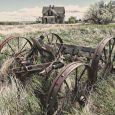
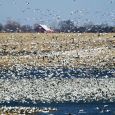
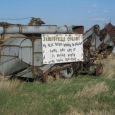

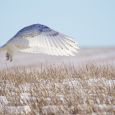


Comments